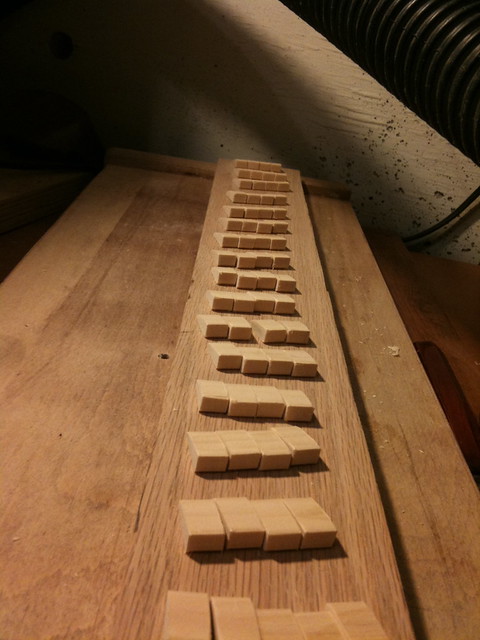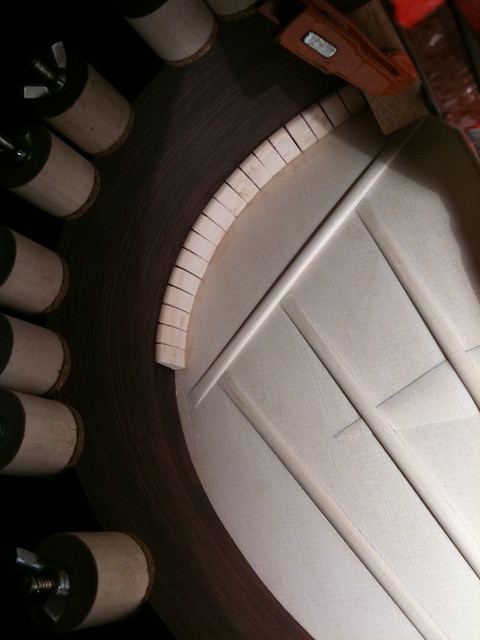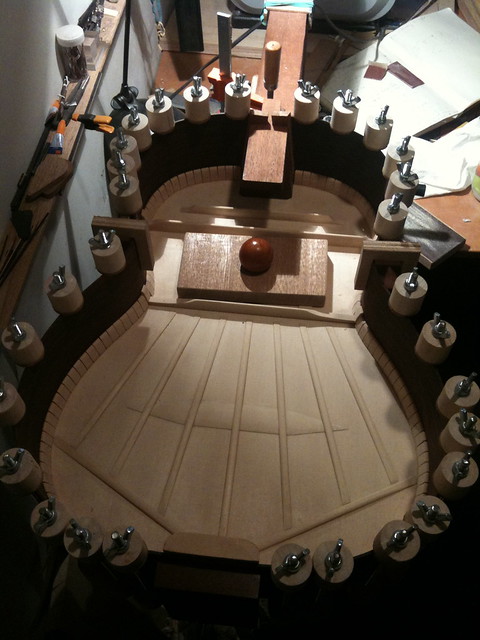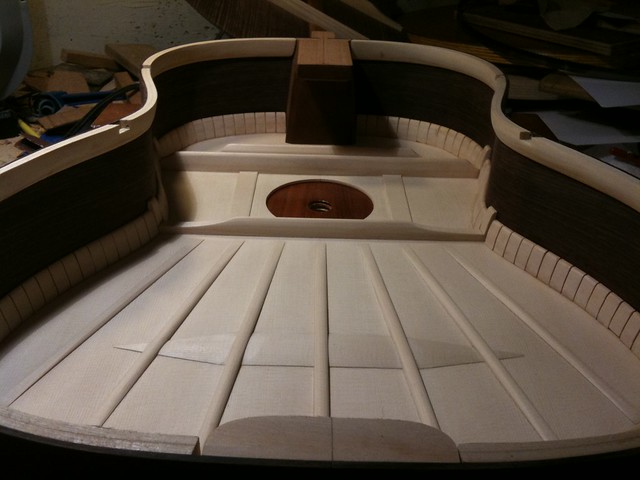After working for such a long time on various components, it's amazing how quickly the guitar becomes something undeniably guitar shaped. In this post I'll show how the sides are glued to the top.
The top and sides are joined by hundreds of individual pieces of spruce. Some guitars use a single strip, with notches cut to allow the 'kerfing' to bend presumably to save time. This was one of the slowest operations in the entire construction. A lot o time was spent between cutting the spruce strips to size, shaping the rounded profile, cutting each piece individually and cleaning the rough edges and then individually gluing each of the hundreds of pieces into place.
First the sides were clamped into place with spool clamps that I made myself. The DIY spool clamps worked out at about a quarter of the cost of the similar clamps offered by Stewart Macdonald. They are made of threaded rod, with two pieces of cork-faced dowel and a wing-nut.
In this photo you can see the clamps holding the side to the base of the solera. You can also see I have started to test fit the spruce pieces, to see how many will be needed for each section.
Once the spacing was figured out (although I'll admit I ended up accidentally deviating from the plan during the gluing process). Each piece was glued with PVA glue, and held in place for a few moments until dry.
The sides are firmly held in place by the spool clamps, the heel and the end block.
Here is a close-up of the final result. The spruce rests up closely against the rosewood sides, and holds the top firmly. I don't think the pieces need to be so close together here, but it doesn't seem to have caused any problems in the finished instrument.
Once the top and sides are firmly glued, I moved on to working on the back lining. The back lining is made from the same spruce material as the top pieces, but is solid. Two strips are cut and bent for each side, before being laminated together. This is done as bending a piece this think is tricky. Once the two pieces have been laminated, they are cut to the correct profile, and glued onto the sides. The sides have been trimmed to the correct height and back profile at this stage.
The final step is to cut notches for the back braces to sit into. These need to be precisely cut as they are very visible through the soundhole of the guitar. They also act as alignment guides when gluing the back.
The back is glued in place using the same spool clamps.
I really love this photo as it shows how beautiful the inside of a guitar can be.
The top and sides are joined by hundreds of individual pieces of spruce. Some guitars use a single strip, with notches cut to allow the 'kerfing' to bend presumably to save time. This was one of the slowest operations in the entire construction. A lot o time was spent between cutting the spruce strips to size, shaping the rounded profile, cutting each piece individually and cleaning the rough edges and then individually gluing each of the hundreds of pieces into place.
First the sides were clamped into place with spool clamps that I made myself. The DIY spool clamps worked out at about a quarter of the cost of the similar clamps offered by Stewart Macdonald. They are made of threaded rod, with two pieces of cork-faced dowel and a wing-nut.
In this photo you can see the clamps holding the side to the base of the solera. You can also see I have started to test fit the spruce pieces, to see how many will be needed for each section.
Once the spacing was figured out (although I'll admit I ended up accidentally deviating from the plan during the gluing process). Each piece was glued with PVA glue, and held in place for a few moments until dry.
The sides are firmly held in place by the spool clamps, the heel and the end block.
Here is a close-up of the final result. The spruce rests up closely against the rosewood sides, and holds the top firmly. I don't think the pieces need to be so close together here, but it doesn't seem to have caused any problems in the finished instrument.
Once the top and sides are firmly glued, I moved on to working on the back lining. The back lining is made from the same spruce material as the top pieces, but is solid. Two strips are cut and bent for each side, before being laminated together. This is done as bending a piece this think is tricky. Once the two pieces have been laminated, they are cut to the correct profile, and glued onto the sides. The sides have been trimmed to the correct height and back profile at this stage.
The final step is to cut notches for the back braces to sit into. These need to be precisely cut as they are very visible through the soundhole of the guitar. They also act as alignment guides when gluing the back.
The back is glued in place using the same spool clamps.
I really love this photo as it shows how beautiful the inside of a guitar can be.






Yes, that last photo is beautiful. (sniff) Umm, it's kinda dusty in here (cough, sniff).
ReplyDeleteThis is very cool. Thanks for taking the time to document your build. But your blog isn't finished! Where's the photo of the finished instrument? And how does it sound?
ReplyDelete